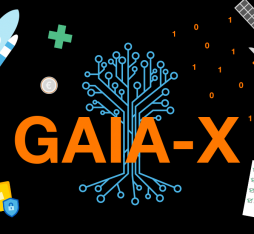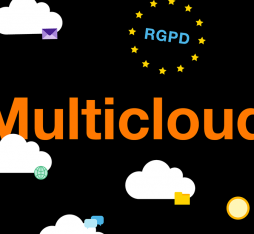“The project is open to all companies, regardless of their nationality. There will be just one requirement to join the Gaia-X ecosystem: respect its values and rules, which are set by European stakeholders.”
As announced on 4 June ahead of an official launch date at the end of September, the Gaia-X Foundation is formed by leaders in French and German industry, such as Deutsche Telekom, Siemens, SAP, BMW, Atos, EDF, Safran and Orange, among others, as well as two academic institutes — Institut Mines-Télécom and Fraunhofer (a German organisation specialising in applied science research, with a notable background in the field of the MP3 digital format). Other member countries will soon join them, because the ambition with Gaia-X is well and truly European. As for Gaia-X itself, the goal is to create data spaces for sharing data, in which all operators can coexist, whether they be European or not, small or even giants like Amazon, Microsoft and Google. For this interoperability between service modules to work, certain barriers will need to be overcome, particularly when it comes to user identification. Through a federated identity, the aim is for Gaia-X users to be recognised by all providers in the ecosystem. The first use cases between different providers should be operational from the beginning of 2021 within preliminary data spaces, which will serve as inaugural use cases.
What is a “sovereign” cloud?
Sovereignty is not just a matter of data localisation or compliance with a regulatory framework. As Cédric Prévost, Head of Trusted Cloud at Orange Business Services and Orange’s representative within the Gaia-X ecosystem, explains, “we have to bear in mind the way the services are operated, the possible extra-territorial legislation that would apply, the technological base, its scalability and the ability for customers to check that their data is being processed in the way they are told. Remember that no solution can fully meet this set of combined criteria with the maximum level of protection and on a purely European basis.” Customers should therefore prioritise the most essential criteria for them, based on their needs and regulatory requirements. By combining different modules, which exist in spite of everything, we end up with a variant of more or less sovereign solutions. This is the digital reality that the European Gaia-X ecosystem wants to tackle head-on, whilst taking care not to fall back on Europe alone. In this complex ecosystem, the method for assuring users that their data will not be compromised is yet to be developed.
Gaia-X applied to AI — a use case example
A provider wants to use a model to improve its hardware failure recognition. Through a Gaia-X data space, the provider pools various pieces of monitoring data collected from its customers, stores the data in one or multiple sovereign clouds (taking into account that this data is sensitive), and uses machine learning. Since the result—a trained model—cannot be traced back to the original data, this predictive model can then be put to use on the market’s most innovative platforms, even if they are not sovereign, without the data being at risk. “This will be the main challenge facing Gaia-X when the time comes to put the notion of data space into effect: combining sovereign services with less sovereign ones, or in other words, ensuring data security. By pooling a great deal of expertise and marrying the views of users with those of providers, the ecosystem will have the ability to write this technical response.” Gaia-X will also need to be able to keep up with the rapid rate of change. While AI is today’s hot topic, others are already emerging, such as computer vision and ‘edge computing’—the future of cloud infrastructure—which are currently on the horizon.
An open ecosystem, but built with European interests in mind
The Gaia-X Foundation—the Gaia-X ecosystem’s governing entity—is established on the legal basis of a non-profit association under Belgian law, mostly to stay close to the European bodies. This is because the project must be coordinated with cross-functional initiatives such as 5G and trans-European connectivity. Nevertheless, the project is open to all companies willing to invest their time, regardless of nationality. There will be just one fundamental requirement to join the foundation: respect its values and rules of procedure (rules), which are set by European stakeholders. For providers, this will likely entail obligations such as having a contractual reversibility clause, or requiring them to declare the legislation applicable to their offer, such as the US Cloud Act. To ensure transparency, Gaia-X will first need to focus on identifying the type of criteria that act as markers of sovereignty for providers in the market. This will help also increase the visibility of existing European solutions at the same time.
Gaia-X — an attractive ecosystem?
Key cloud stakeholders have expressed their interest in Gaia-X. It is worth noting that they own two-thirds of the public cloud market in Europe and that, over the coming decades, Gaia-X will focus these stakes on the continent. Furthermore, ‘hyperscalers’ (companies carrying out very large-scale IT operations) already seem to be present in the technical working groups that were launched at the outset of the project in Germany. But does that guarantee the ecosystem will succeed? “For Gaia-X, the stakes are on a European scale. Previous sovereign cloud attempts were made at the national level. France, Germany, the UK, Japan and Canada have domestic markets that are too weak to support such levels of investment in the cloud infrastructure market alone. Possessing large domestic markets is one reason why China and the US have been able to do well. In addition to the cloud infrastructure, Gaia-X is now focusing on data services, in other words, where the value lies for customers. It has the backing of the French and German governments for now, and soon many other member States will join to make it a fully European project. It’s no coincidence that Gaia-X is one of the few concrete projects mentioned in the digital strategy published by the European Commission in February. So, I think we can safely say that with Gaia-X, European sovereignty is treading a new path — one that is no longer opposed to digital innovation! The Gaia-X community is dynamic and committed. The next few months will be crucial for this collaboration to succeed and for the caterpillar to transform into a butterfly.”







